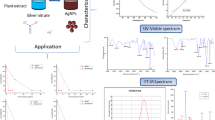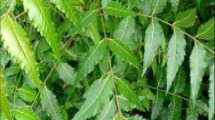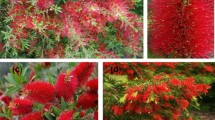Abstract
Larvicides play a vital role in controlling mosquitoes in their breeding sites. The present study was carried out to establish the larvicidal activities of mycosynthesized silver nanoparticles (AgNPs) against vectors: Aedes aegypti and Anopheles stephensi responsible for diseases of public health importance. The AgNPs synthesized by filamentous fungus Cochliobolus lunatus, characterized by UV–Vis spectrophotometry, Fourier transform infrared spectroscopy, X-ray diffraction, scanning electron microscopy, and transmission electron microscopy. The characterization studies confirmed the spherical shape and size (3–21 nm) of silver nanoparticles. The efficacy of mycosynthesized AgNPs at all the tested concentrations (10, 5, 2.5, 1.25, 0.625, and 0.3125 ppm) against second, third, and fourth instar larvae of A. aegypti (LC50 1.29, 1.48, and 1.58; LC90 3.08, 3.33, and 3.41 ppm) and against A. stephensi (LC50 1.17, 1.30, and 1.41; LC90 2.99, 3.13, and 3.29 ppm) were observed, respectively. The mortality rates were positively correlated with the concentration of AgNPs. Significant (P < 0.05) changes in the larval mortality was also recorded between the period of exposure against fourth instar larvae of A. aegypti and A. stephensi. The possible larvicidal activity may be due to penetration of nanoparticles through membrane. Toxicity studies carried out against non-target fish species Poecilia reticulata, the most common organism in the habitats of A. aegypti and A. stephensi showed no toxicity at LC50 and LC90 doses of the AgNPs. This is the first report on mosquito larvicidal activity of mycosynthesized nanoparticles. Thus, the use of fungus C. lunatus to synthesize silver nanoparticles is a rapid, eco-friendly, and a single-step approach and the AgNps formed can be potential mosquito larvicidal agents.








Similar content being viewed by others
References
Abbott WS (1925) A method of computing the effectiveness of an insecticide. J Eco Entomol 18:265–266
Ahmad A, Mukherjee P, Senapati S, Mandal D, Khan MI, Kumar R, Sastry M (2003) Extracellular biosynthesis of silver nanoparticles using the fungus Fusarium oxysporum. Colloids Surf B 28:313–318
Aiub CAF, Coelho ECA, Sodre E, Pinto LFR, Felzenszwalb I (2002) Genotoxic evaluaton of the organophosphorous pesticide temephos. Genet Mol Res 101:159–166
AlesPana C, Milan KR, Renata V, Robert P, Jana S, Vladimır K, Petr H, Radek Z, Libor K (2009) Antifungal activity of silver nanoparticles against Candida spp. Biomaterials 30:6333–6340
Ali A, Nayar JK, Xue RD (1995) Comparative toxicity of selected larvicides and insect growth regulators to a Florida laboratory, population of Aedes albopictus. J Am Mosq Control Assoc 11(1):72–76
Amer A, Mehlhorn H (2006) Larvicidal effects of various essential oils against Aedes, Anopheles, and Culex larvae (Diptera, Culicidae). Parasitol Res 99:466–472
Balaji DS, Basavaraja S, Deshpande R, Mahesh DB, Prabhakar BK, Venkatraman A (2009) Extracellular biosynthesis of functionalized silver nanoparticles by strains of Cladosporium cladosporioides fungus. Colloides Surf B Biointerf 68(1):88–92
Braga IA, Lima JBP, Soares SS, Valle D (2004) Aedes aegypti resistance to temephos during 2001 in several municipalities in the states of Rio de Janeiro, Sergipe and Alagoas. Brazil Mem Inst Oswaldo Cruz 99:199–203
Chen JC, Lin ZH, Ma XX (2003) Evidence of the production of silver nanoparticles via pretreatment of Phoma sp. 3.2883 with silver nitrate. Letters in Applied Microbiology 37:105–108
Choi O, Deng KK, Kim NJ, Ross JR, Surampalli RY, Hu Z (2008) The inhibitory effects of silver nanoparticles, silver ions and silver chloride colloids on microbial growth. Water Res 42:3066–3074
Dias MA, Lacerda ICA, Pimentel PF, de Castro HF, Rosa CA (2002) Removal of heavy metals by an Aspergillus terreus strain immobilized in a polyurethane matrix. Letters in Applied Microbiology 34:46–50
Durán N, Marcato PD, Alves OL, De Souza GIH, Esposito E (2005) Mechanistic aspects of biosynthesis of silver nanoparticles by several Fusarium oxysporum strains. J Nanobiotechnol 3:8
Enserink M (2006) Massive outbreak draws fresh attention to little-known virus. Science 311:1085
Fayaz AM, Balaji K, Girilal M, Yadav R, Thangavelu P, Venketesan KR (2010) Biogenic synthesis of silver nanoparticles and their synergistic effect with antibiotics: a study against Gram-positive and Gram-negative bacteria. Nanomed Nanotechnol Biol Med 6:103–109
Finney DJ (1971) Probit analysis. Cambridge University Press, Cambridge, pp 76–80
Griffitt RJ, Luo J, Gao J, Bonzongo JC, Barber DS (2008) Effects of particle composition and species on toxicity of metallic nanomaterials in aquatic organisms. Environ Toxicol Chem 27:1972–1978
Huang CP, Juang CP, Morehart K, Allen L (1990) The removal of copper(II) from dilute aqueous solutions by Saccharomyces cerevisiae. Water Research 24:433–439
James VR, Christopher V, Parkinson YW, Choi JL, Speshock SM, Hussain (2008) Preliminary assessment of silver nanoparticle inhibition of Monkeypox virus plaque formation. Nanoscale Research Letters 3:129–133
Kamaraj C, Rahuman AA, Bagavan A (2008) Antifeedant and larvicidal effects of plant extracts against Spodoptera litura (F.), Aedes aegypti L. and Culex quinquefasciatus Say. Parasitol Res 03:325–331
Krishnaraj C, Jagan EG, Rajasekar S, Selvakumar P, Kalaichelvan PT, Mohan N (2010) Synthesis of silver nanoparticles using Acalypha indica leaf extracts and its antibacterial activity against water borne pathogens. Colloids Surf B Biointerfaces 76(1):50–56
Kumar S, Warikoo R, Wahab N (2010) Larvicidal potential of ethanolic extracts of dried fruits of three species of peppercorns against different instars of an Indian strain of dengue fever mosquito, Aedes aegypti L. (Diptera: Culicidae). Parasitol Res 107(4):901–907
Kurihara K, Rockstuhl C, Nakano T, Arai T, Tominaga J (2005) The size control of silver nano-particles in SiO2 matrix film. Nanotechnology 16:1565–1568
Lanisnik RT, Moeller G, Thole HH, Zakelj-Mavric M, Adamski J (1999) A novel 17β-hydroxysteroid dehydrogenase in the fungus Cochliobolus lunatus: new insights into the evolution of steroid hormone signaling. Biochem J 337:425–431
Lara HH, Ayala-Nuñez NV, Ixtepan TL, Rodriguez PC (2010) Mode of antiviral action of silver nanoparticles against HIV-1. Journal of Nanobiotechnology 8:1
Lok CM, Ho CM, Chen R, He QY, Yu WY (2006) Proteomic analysis of the mode of antibacterial action of silver nanoparticles. J of Proteome Res 5:916–924
Marimuthu S, Rahuman AA, Govindasamy R, Thirunavukkarasu S, Arivarasan VK, Chidambaram J, Asokan B, Zahir AA, Elango G, Chinnaperumal K (2010) Evaluation of green synthesized silver nanoparticles against parasites. Parasitol Res. doi:10.1007/s00436-010-2212-4
Mathew N, Anitha MG, Bala TSL, Sivakumar SM, Narmadha R, Kalyanasundaram M (2009) Larvicidal activity of Saraca indica, Nyctanthes arbor-tristis, and Clitoria ternatea extracts against three mosquito vector species. Parasitol Res 104:1017–1025
Melo-Santos MAV, Varjal-Melo JJM, Araujo AP, Gomes TCS, Paiva MHS (2010) Resistance to the organophosphate temephos: mechanism, evolution and reversion in an Aedes aegypti laboratory strain from Brazil. Acta Tropica 113:180–189
Mohanpuria P, Rana NK, Yadav SK (2008) Biosynthesis of nanoparticles: technological concepts and future applications. J Nanopart Res 10:507–517
Moretti MDL, Sanna-Passino G, Demontis S, Bazzoni E (2002) Essential oil formulations useful as a new tool for insect pest control. AAPS PharmSciTech 13:1–11
Patil RH, Patil SV, Patil UK, Bhat JA, Rajput J, Chaudhry R (2008) Biotransformation of Rifamycin B to Rifamycin S with free and immobilized cells of Curvularia lunata. Journal of Applied and Pure Microbiology 2(1):111–114
Patil CD, Patil SV, Salunke BK, Salunkhe RB (2010a) Bioefficacy of Plumbago zeylanica (Plumbaginaceae) and Cestrum nocturnum (Solanaceae) plant extracts against Aedes aegypti (Diptera: Culicide) and nontarget fish Poecilia reticulata. Parasitol Res. doi:10.1007/s00436-010-2174-6
Patil SV, Patil CD, Salunke BK, Salunkhe RB (2010b) Larvicidal efficacy of six plants against two mosquito species Aedes aegypti and Anopheles stephensi. Trop Biomed 27(3):360–365
Pinheiro VCS, Tader WP (2002) Evaluation of the residual effect of temephos on Aedes aegypti (Diptera: Culicidae) larvae in artificial containers in Manaus. Amazonas state, Brazil Cad Saude Publica 18:1529–1535
Rahman SJ, Sharma SK, Rajagopal (1989) Manual on entomological surveillance of vector borne diseases. NICD, New Delhi
Rahuman RR, Venketesan P (2008) Larvicidal efficacy of five cucurbitaceous plant leaf extracts against mosquito species. Pararsitol Res 103:133–139
Rahuman AA, Bagavan A, Kamaraj C, Saravanan E, Zahir AA, Elango G (2009a) Efficacy of larvicidal botanical extracts against Culex quinquefasciatus Say (Diptera: Culicidae). Parasitol Res 104:1365–1372
Rahuman AA, Bagavan A, Kamaraj C, Vadivelu M, Zahir AA, Elango G, Pandiyan G (2009b) Evaluation of indigenous plant extracts against larvae of Culex quinquefasciatus Say (Diptera: Culicidae). Parasitol Res 104:637–643
Rai MA, Yadav A, Gade A (2009) Silver nanoparticles as a new generation of antimicrobials. Biotechnology Advances 27:76–83
Ravi V (2006) Re-emergence of Chikungunya virus in India. Ind J Med Microbiol 24(2):83–84
Sabina B, Ljerka L, Branka K, Nada K, Radovan K (2008) Progesterone-induced gene expression profile of the filamentous fungus Cochliobolus lunatus. Acta Chim Slov 55:93–100
Sakulku U, Nuchuchua O, Uawongyart N, Puttipipatkhachorn S, Soottitantawat A, Ruktanonchai U (2009) Characterization and mosquito repellent activity of citronella oil nanoemulsion. Int J Pharm 372:105–111
Sangiliyandi G, Kalimuthu K, Ramanathan V, Venkataraman D, Sureshbabu RP, Jeyaraj M, Nellaiah H, Soo HE (2009) Biosynthesis, purification and characterization of silver nanoparticles using Escherichia coli. Colloids and Surfaces B: Biointerfaces 74:328–335
Sap-Iam N, Homklinchan C, Larpudomlert R, Warisnoicharoen W, Sereemaspun A, Dubas ST (2010) UV irradiation induced silver nanoparticles as mosquito larvicides. J Applied Sci 10(23):3132–3136 (ISSN 1812–5654)
Sastry M, Absar AA, Khan MI, Kumar R (2003) Biosynthesis of metal nanoparticles using fungi and actinomycete. Current Science 85(2):162–170
Shaalan EAS, Canyonb D, Younesc MWF, Abdel-Wahaba H, Mansoura AH (2005) A review of botanical phytochemicals with mosquitocidal potential. Environ Int 31:1149–1166
Sharma P, Mohan L, Srivastava CN (2009) Amaranthus oleracea and Euphorbia hirta: natural potential larvicidal agents against the urban Indian malaria vector, Anopheles stephensi Liston (Diptera: Culicidae). Parasitol Res 106:171–176
Shrivastava S, Dash D (2010) Label-free colorimetric estimation of proteins using nanoparticles of silver. Nano-Micro Lett 2:164168
Silver S (2003) Bacterial silver resistance: molecular biology and uses and misuses of silver compounds. FEMS Microbiol Rev 27:341–353
Sondi I, Salopek SB (2004) Silver nanoparticles as antimicrobial agent: a case study on E. coli as model for Gram negative bacteria. J Colloid Interface Sci 275:177–182
Su T, Mulla MS (1998) Ovicidal activity of neem products (Azadirachtin) against Culex tarsalis and Culex quinquefasciatus (Diptera: Culicidae). Journal of American Mosquito Control Association 14:204–209
Tea Lanisc NRN, Gabriele M, Hubert HT, Marija ZCAM, Jerzy A (1999) A novel 17β-hydroxysteroid dehydrogenase in the fungus Cochliobolus lunatus: new insights into the evolution of steroid-hormone signaling. Biochem J 337:425–431
Thirunavukkarasu S, Rahuman AA, Govindasamy R, Marimuthu S, Asokan B, Chidambaram J, Zahir AA, Elango G, Chinnaperumal K (2010) Synthesis of silver nanoparticles using Nelumbo nucifera leaf extract and its larvicidal activity against malaria and filariasis vectors. Parasitol Res. doi:10.1007/s00436-010-2115-4
Vigneshwaran N, Ashtaputre NM, Varadarajan PV, Nachane RP, Paralikar KM, Balasubramanya RH (2007) Biological synthesis of silver nanoparticles using the fungus. Aspergillus flavus Materials Letters 61:1413–1418
Volesky B, Holan ZR (1995) Biosorption of heavy metals. Biotechnology Progress 11(3):235–250
Wang L, Li X, Zhang G, Dong J, Eastoe J (2007) Oil-in-water nanoemulsions for pesticide formulations. J Colloid Interface Sci 314:230–235
Wen-Ru L, Xiao-Bao X, Qing-Shan S, Hai-Yan Z, You-Sheng OU-Y, Yi-Ben C (2010) Antibacterial activity and mechanism of silver nanoparticles on Escherichia coli. Appl Microbiol Biotechnol 85:1115–1122
WHO (1996) Report of the WHO informal consultation on the evaluation on the testing of insecticides CTD/WHO PES/IC/96.1:p. 69
WHO (2006) Chikungunya and dengue in the south west Indian Ocean. Epidemic and Pandemic Alert and Response (EPR). Available at http://www.who.int/csr/don/2006
Zarchi AAK, Mahmoodzadeh A, Vatani H (2006) A survey on malaria and some related factors in south east of Caspian Sea. Pak J Med Sci 22(4):489–492
Acknowledgement
Authors are thankful to All India Institute of Medical Sciences (AIIMS), New Delhi for TEM analysis of silver nanoparticles.
Author information
Authors and Affiliations
Corresponding author
Rights and permissions
About this article
Cite this article
Salunkhe, R.B., Patil, S.V., Patil, C.D. et al. Larvicidal potential of silver nanoparticles synthesized using fungus Cochliobolus lunatus against Aedes aegypti (Linnaeus, 1762) and Anopheles stephensi Liston (Diptera; Culicidae). Parasitol Res 109, 823–831 (2011). https://doi.org/10.1007/s00436-011-2328-1
Received:
Accepted:
Published:
Issue Date:
DOI: https://doi.org/10.1007/s00436-011-2328-1




